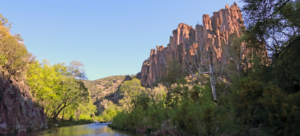
By Mark Allison, Executive Director
Ten years ago, New Mexico Wild was proud to welcome over 1,100 people from across the country to Albuquerque to celebrate the 50th anniversary of the Wilderness Act. This year, we’re excited to celebrate the 100th anniversary of the world’s first administratively designated wilderness area — right here in New Mexico.
The Gila Wilderness in southwestern New Mexico was premised on a profoundly new “land ethic” conceived by a young forester named Aldo Leopold. This new ethic was based on humility and restraint, where wild places are allowed to be “self-willed.” He famously said, “A thing is right when it tends to preserve the integrity, stability and beauty of the biotic community. It is wrong when it tends otherwise,” and emphasized that ecosystems and species, including humans, are interconnected.
For non-Indigenous, Western thinking, this was a radical, new way to look at our relationship with the natural world, one that countered the human-centric and nature-dominating sentiment that came before.
For context, the state of New Mexico’s lands and wildlife in 1924 was dire. Unregulated commercial logging had stripped whole mountain ranges bare and decimated wildlife, with bison, elk and Rocky Mountain bighorn sheep completely gone.
Wilderness is a formal designation for federal public lands, the gold standard of conservation. The bipartisan Wilderness Act was transformational in its intent and implications. For the first time, a law enabled protection of lands for their inherent wildness, safeguarding them forever from commercialization and extraction, roads, mechanization and motorization, providing a new tool to counter relentless development and commodification.
The law is also uniquely American and asserted a new citizen-led right in protecting public lands, from what had been top-down federal agency discretion to one that empowers ordinary citizens to petition their representatives to do so legislatively.
Today, New Mexico is fortunate to have 39 wilderness areas, representing 1,981,947 acres, or about 2.5% of our total land area. While a small percentage, these lands play essential roles safeguarding cultural resources and sites sacred to Indigenous peoples; traditional uses such as hunting, fishing and herb gathering; and opportunities for recreation and solitude. They are a boon to our tourism and outdoor recreation economy.
They offer critical habitat and corridors for wildlife. Wilderness areas also play a significant role in climate change mitigation, adaptation and resiliency, and in combatting mass species extinction.
Even as we celebrate this milestone anniversary, we know there is more to be done. We owe it to future generations — human and wildlife alike — to do what we can to save what is left before it is gone forever. We’re grateful to continue to do so with tribes and pueblos, traditional communities, businesses, faith-based groups and other stakeholders.
We also know designating a place isn’t enough. Our staff and volunteers are proud to work with land management agencies on trail work, documenting abuses and stewardship.
All supporters of wilderness don’t necessarily have the same motivations, nor must they. Regardless, their support is deeply rooted in the values, traditions and cultures that make us proud New Mexicans and Americans. We honor wisdom and prudence, recognize an obligation to posterity and cringe at thoughtless waste.
We’re grateful for the foresight of Aldo Leopold and others who came before us, and proud of the special role New Mexico played — and still plays —in conservation.
Mark Allison is the executive director of New Mexico Wild, a statewide organization dedicated to conserving wilderness, waters and wildlife.
This op-ed was published in the Santa Fe New Mexican on June 4th, 2024.

